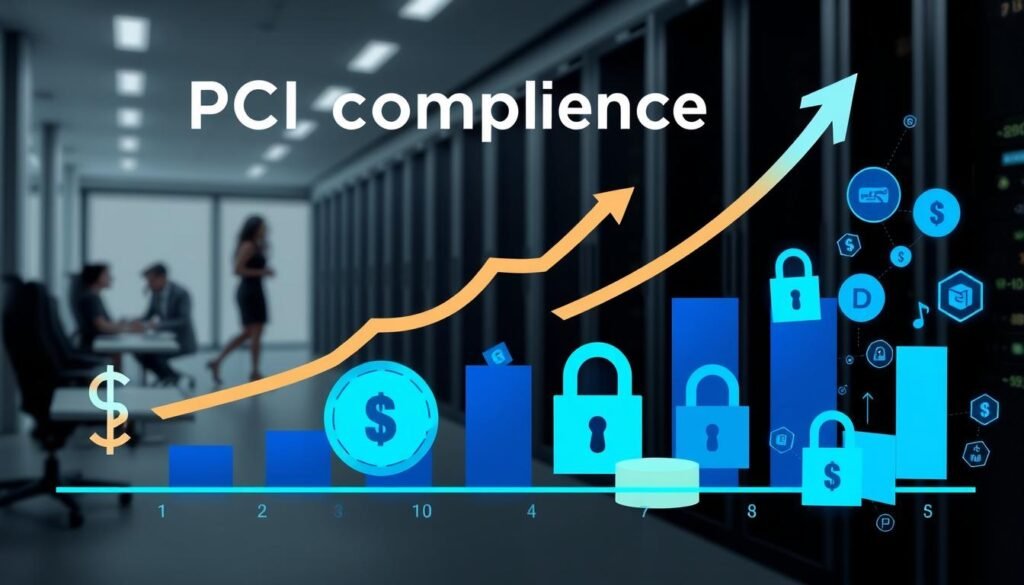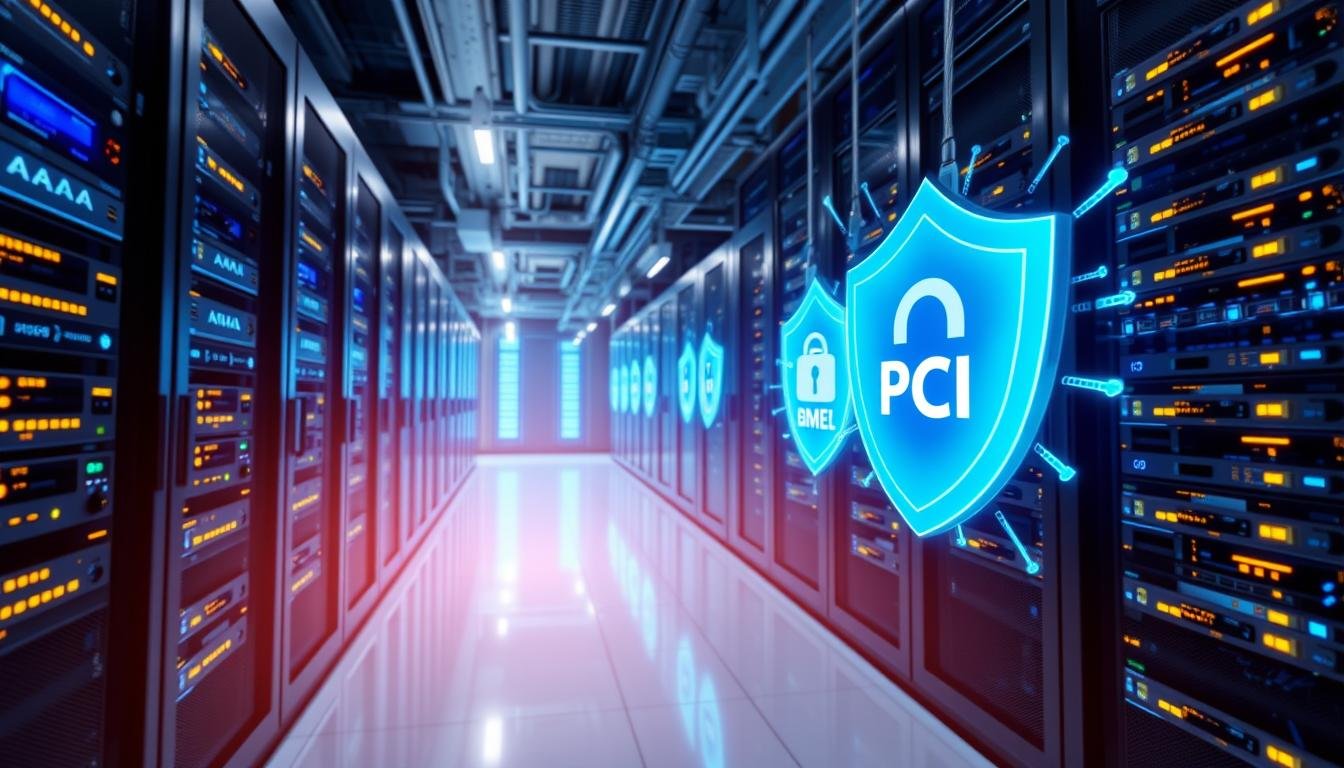Businesses today face a fast-changing digital world. Ensuring payment card security is a must. The Payment Card Industry Data Security Standard (PCI DSS) is the key standard for this. It sets strict rules for companies that handle credit card transactions.
Meeting PCI DSS standards is crucial for protecting customer data and avoiding expensive data breaches. However, the cost of achieving and keeping up with this standard worries many businesses.
In this article, we’ll look at the different costs of becoming PCI compliant. We’ll break it down to help businesses understand what it takes to protect their payment systems and customer info. We’ll cover everything from the first steps to ongoing costs.

Key Takeaways
- PCI DSS compliance is a critical requirement for businesses handling credit card transactions, ensuring the protection of customer data and mitigating the risk of costly data breaches.
- The financial investment required for PCI DSS compliance can be significant, with various cost factors to consider, including initial assessment, implementation, ongoing maintenance, and third-party validation.
- Understanding the comprehensive breakdown of PCI compliance costs can help organizations budget and plan effectively, ensuring they meet the necessary requirements while optimizing their resources.
- Businesses should explore cost-saving strategies, such as efficient resource allocation and the use of compliance management tools, to minimize the financial burden of PCI DSS compliance.
- Proactively addressing potential hidden costs and common pitfalls can help organizations avoid unexpected expenses and maintain long-term compliance.
Understanding PCI DSS Compliance Basics
Payment Card Industry Data Security Standard (PCI DSS) is a set of security standards. It protects sensitive payment card information. It’s key to keeping customers’ financial data safe and building trust in online transactions.
What is PCI DSS and Why It Matters
PCI DSS is a global rule set by major payment card brands. These include Visa, Mastercard, American Express, Discover, and JCB. It gives a framework for any company that handles credit card data.
Following PCI DSS is vital to avoid data breaches. It helps protect both businesses and their customers from fraud and identity theft.
Key Components of PCI Compliance
The PCI DSS framework has six main goals:
- Build and maintain a secure network and systems
- Protect cardholder data
- Maintain a vulnerability management program
- Implement strong access control measures
- Regularly monitor and test networks
- Maintain an information security policy
These detailed rules ensure businesses handle payment data carefully.
Compliance Levels and Requirements
The PCI DSS rules change based on how much transaction a company does. Businesses are put into different levels of compliance. Each level has its own standards and checks.
Knowing these levels helps companies figure out what steps and resources they need. This is to meet and keep PCI compliance.
By following PCI DSS, companies show they care about protecting their customers’ payment info. This improves the security of online payments for everyone.
Initial Assessment and Planning Expenses
Getting PCI compliant takes time. The first steps involve costs for assessments, planning, and audits. PCI compliance assessment costs, compliance planning fees, and initial audit expenses are key investments for any organization.
The first step is a gap analysis to find areas for improvement. This helps organizations see where they stand and plan their path to compliance. The cost of this initial step can vary, from a few thousand dollars for small businesses to tens of thousands for larger ones.
Next, organizations create a detailed compliance plan. This plan outlines how they will meet PCI DSS requirements. Getting help from PCI compliance experts can add to the compliance planning fees. Costs can range from a few hundred dollars for small businesses to several thousand for larger ones.
After planning, organizations undergo an initial audit to check their compliance. This initial audit expense is crucial as it confirms the security controls are in place. The audit cost varies based on the organization’s size, complexity, and the QSA chosen.
| Cost Category | Estimated Range |
|---|---|
| PCI compliance assessment costs | $2,000 – $50,000 |
| Compliance planning fees | $500 – $10,000 |
| Initial audit expenses | $5,000 – $50,000 |
These initial costs are just the start of the PCI compliance journey. Organizations must also invest in ongoing maintenance, security, and staff training. By understanding these costs, businesses can better plan for the total investment needed for PCI DSS compliance.
How Much Does It Cost to Become PCI Compliant: A Complete Breakdown
Getting PCI compliant is key for businesses that deal with credit card payments. But, it’s not cheap. The cost to get compliant can change a lot. It depends on your business size, IT setup, and what you need to do.
Direct Implementation Costs
The main costs are for direct implementation. This includes buying security tools, upgrading your network, and setting up data encryption. You might also need to train your staff on PCI DSS rules.
Indirect Cost Factors
There are also indirect costs to think about. These include lost productivity, hiring more IT staff, and the cost of regular audits.
Ongoing Maintenance Expenses
After you’re compliant, there are ongoing costs. These include yearly assessments, keeping security tools up to date, and making sure you stay compliant.
| Cost Category | Estimated Range |
|---|---|
| PCI compliance implementation costs | $10,000 – $50,000+ |
| Direct expenses | $5,000 – $30,000 |
| Indirect cost factors | $5,000 – $20,000 |
| Ongoing maintenance fees | $2,000 – $10,000 per year |
Keep in mind, these are just rough guesses. The real costs can differ a lot based on your business. Knowing these costs helps you plan and budget for PCI compliance.
Technology Infrastructure Investment Requirements
To become PCI compliant, you need to invest in your technology. This includes upgrading systems and adding PCI compliant technology. Focus on the upgrades and improvements needed to meet PCI DSS standards.
Upgrading your network and servers is key. You might need to replace old hardware and add secure data storage. Also, integrating new software can help with PCI compliance and protect cardholder data.
| Infrastructure Upgrade | Estimated Cost |
|---|---|
| Network Firewall Replacement | $5,000 – $15,000 |
| Secure Data Storage Solution | $10,000 – $50,000 |
| PCI Compliant Payment Gateway | $1,000 – $5,000 setup, plus monthly fees |
| Vulnerability Scanning Software | $2,000 – $10,000 per year |
These are some of the technology infrastructure investments needed for PCI compliance. Costs vary based on your organization’s size and industry needs.

Plan and budget for these upgrades to keep your business PCI compliant. The right PCI compliant technology and IT system improvements protect your customers’ data and build trust.
Security Software and Hardware Costs
To meet PCI compliance, you need to invest in strong security tools. These tools are key to protecting payment info and following PCI Security Standards Council rules.
Essential Security Tools
At the heart of PCI compliance are vital security tools. These include PCI security software, firewalls, and antivirus programs. They help stop unauthorized access, watch network activity, and fight off malware and cyber threats.
Network Security Solutions
Another key part of PCI compliance is network security solutions. This means using intrusion detection and prevention systems, VPNs, and secure wireless access points. They keep the payment processing system safe and sound.
Data Encryption Systems
Protecting cardholder data is crucial. Organizations must use encryption systems that meet PCI DSS standards. This means using strong encryption, secure key management, and access controls to keep data safe from unauthorized access.
Using these security tools together is vital for PCI compliance and protecting customer data. The right technology can lower data breach risks and avoid expensive penalties for non-compliance.
Staff Training and Education Expenses
Ensuring your organization’s PCI compliance is more than just tech. It also needs employee education programs. These programs help create a culture of security awareness. The costs for staff training and ongoing security awareness are key when budgeting for PCI compliance.
The cost of PCI compliance training costs can change a lot. It depends on your organization’s size, how complex your operations are, and what training you need. These costs might include making custom training materials, using e-learning platforms, and hosting in-person workshops and seminars.
Keeping a strong security posture also means ongoing security awareness training for all employees. This keeps your team alert and informed about the latest PCI DSS rules and best practices for protecting sensitive data.
| Training Type | Estimated Cost Range |
|---|---|
| PCI Compliance Training | $50 – $300 per employee |
| Security Awareness Programs | $20 – $100 per employee, annually |
| Specialized Workshops and Seminars | $1,000 – $5,000 per event |
Investing in employee education and security awareness is crucial. It helps prevent data breaches and ensures PCI DSS compliance. Though these costs are high, they are vital for a strong security posture and protecting your business and customers.

Third-Party Assessment and Validation Fees
To stay PCI compliant, you need to do a lot of third-party checks. These are done by Qualified Security Assessors (QSAs) and Approved Scanning Vendors (ASVs). They charge for their work. Knowing how much it costs is key for any business trying to follow PCI rules.
QSA Costs
QSAs are experts who do deep audits to make sure you follow PCI DSS rules. Their fees change based on your business size, how complex it is, and their experience. You might pay between $15,000 and $50,000 for a full QSA check.
ASV Scanning Expenses
You also need to get an ASV to scan your network for weaknesses. These scans help find and fix security issues that could hurt your PCI status. ASV scanning costs can be from $500 to $5,000 a year, based on your network’s size and complexity.
The costs for QSA work and ASV scans add up. But, these services are vital for keeping cardholder data safe and following PCI DSS rules.
| Compliance Requirement | Estimated Cost Range |
|---|---|
| Qualified Security Assessor (QSA) Fees | $15,000 – $50,000 |
| Approved Scanning Vendor (ASV) Scanning Expenses | $500 – $5,000 per year |
Spending on these third-party services is a big part of keeping PCI compliance. It helps protect your business’s good name and keeps your customers’ payment info safe.
Annual Maintenance and Monitoring Costs
Getting PCI compliance is just the start. Keeping it up every year takes a lot of work and money. The PCI compliance maintenance fees, ongoing monitoring expenses, and annual compliance costs can really add up. It’s key for companies to plan their budgets well.
Keeping your systems and data safe means regular security updates and checks. These tasks cost money and are a big part of your yearly budget for PCI compliance.
Also, don’t forget the cost of PCI DSS assessments. These are done by Qualified Security Assessors (QSAs) to check if you’re still following the rules. These checks are important but can be pricey.
| Cost Category | Average Annual Expense |
|---|---|
| Security updates and patches | $10,000 – $25,000 |
| Vulnerability assessments | $5,000 – $15,000 |
| Continuous monitoring | $15,000 – $30,000 |
| PCI DSS assessment | $20,000 – $50,000 |
Knowing and planning for these ongoing monitoring expenses and annual compliance costs helps keep your PCI compliance strong. This way, your efforts can last a long time.
“Maintaining PCI compliance is an ongoing process, not a one-time event. Failing to allocate sufficient resources for PCI compliance maintenance fees can put your organization at risk.”
Cost-Saving Strategies for PCI Compliance
Getting PCI compliance can cost a lot, but smart planning can help. Businesses can save money by using resources wisely and with the right tools. This way, they can keep their security strong without spending too much.
Efficient Resource Allocation
Planning well and using resources smartly is key to saving money. Companies should check their setup, find ways to save, and focus on what’s most important. Using what they already have can cut down on the cost of getting compliant.
Compliance Management Tools
Special software for managing compliance is also very helpful. It makes tasks like paperwork and checks easier. This means companies can use less staff and spend less on compliance.
These tools also give insights and data in real-time. This helps companies spot where they can do better and make smart choices. It’s a way to avoid wasting money and use resources well.
“Utilizing compliance management tools can be a game-changer for businesses looking to reduce the financial burden of PCI compliance without compromising security.”
By using these smart strategies, companies can cut down on PCI compliance costs. They can also make the most of compliance management software to make their compliance work better. This helps them stay safe and save money.
Common Hidden Costs and How to Avoid Them
When companies start their PCI compliance journey, they often miss hidden expenses. These can include unexpected staffing needs and underestimated infrastructure upgrades. With the right strategies, businesses can avoid these financial surprises and keep their compliance process smooth.
One big hidden cost is the need for more staff. Compliance often requires special skills, which might mean hiring new people or outsourcing tasks. By planning ahead for these needs, you can avoid unexpected hiring costs.
Another cost often overlooked is the ongoing upkeep of PCI-compliant systems. This includes software updates, security patches, and regular checks for vulnerabilities. Using cost-effective tools and automating tasks can help manage these expenses.
Businesses also might not plan for infrastructure upgrades needed for PCI DSS. A thorough check of your systems and planning for upgrades can help you budget for these unexpected PCI compliance expenses.
To avoid hidden costs and keep finances in check, adopting cost avoidance strategies is key. This means:
- Working with PCI experts to spot cost risks
- Having a proactive compliance management plan
- Using affordable tools and technologies
- Regularly reviewing and improving your compliance program
By being proactive and anticipating these hidden costs, businesses can confidently navigate PCI compliance. This ensures their investment pays off as planned.
Conclusion
Becoming PCI compliant is key for businesses that deal with credit card transactions. The costs can vary a lot. This depends on your business size, security setup, and compliance needs.
The initial and ongoing costs might seem high. But, the benefits of PCI compliance are huge. These include better data security, more customer trust, and less risk of data breaches.
By understanding the costs and using smart strategies, businesses can save money. This makes their PCI compliance efforts both effective and wise.
Keeping up with PCI DSS compliance is a big investment in your business’s future. It protects your customers’ sensitive info. By focusing on data security and improving your compliance, you can grow and succeed in the digital world.
FAQ
What is PCI DSS and why is it important?
PCI DSS stands for Payment Card Industry Data Security Standard. It’s a set of rules to keep credit card info safe. It’s key because it guards businesses and their customers from data theft and fraud. These issues can hurt a company’s finances and reputation a lot.
What are the key components of PCI compliance?
PCI compliance focuses on a few main areas. First, securing your network is crucial. Then, protecting cardholder data is essential. You also need a plan to manage vulnerabilities and strong access controls.
Regular security checks and a solid information security policy are also important. These steps help keep your systems safe and compliant.
What are the different PCI compliance levels?
PCI compliance levels depend on how many credit card transactions a business handles. Levels range from Level 1, for over 6 million transactions, to Level 4, for under 1 million. Each level has its own set of rules to follow.
What are the direct costs of becoming PCI compliant?
Direct costs include the cost of gap analyses and risk assessments. You’ll also need to develop a compliance plan. Implementing security solutions and upgrading your infrastructure are other expenses.
Lastly, hiring third-party assessors and scanning vendors to check your compliance adds to the cost.
What are the indirect cost factors to consider?
Indirect costs include lost productivity and employee training. You’ll also have ongoing expenses for security updates and monitoring. Regular assessments are another cost to consider.
What types of security software and hardware are required for PCI compliance?
You’ll need firewalls, intrusion detection systems, and antivirus software. Data encryption and secure networks are also required. Depending on your business, you might need more tools to meet PCI DSS standards.
How much do third-party assessments and validations cost?
Third-party assessment costs vary. They include fees for QSAs for on-site audits and ASVs for scans. These costs can be thousands or tens of thousands of dollars, based on your business size and complexity.
What are some cost-saving strategies for PCI compliance?
To save money, allocate resources wisely. Use compliance tools to make processes easier. Use in-house expertise and negotiate with service providers. Be aware of hidden costs and plan ahead to avoid them.
